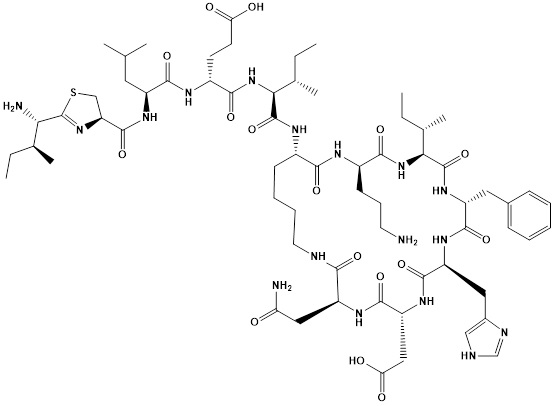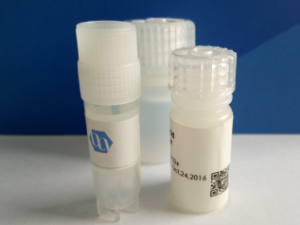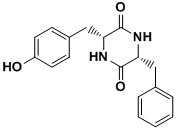Original price was: $ 800.0.$ 600.0Current price is: $ 600.0.
Quantity: 10mg
In stock
Description
Product name: Bacitracin
Catalog#: 1381011
CAS NO.: 1405-87-4
Sequence: Ile-Cys-Leu-D-Glu-Ile-Lys-D-Orn-Ile-D-Phe-His-D-Asp-Asn
Modifications: Cyclization Lys6-Asn12, thiazoline ring Ile-Cys,
M.W: 1422.69
M.F.: C66H103N17O16S
Purity: 95%
Format: Slight yellow powder
Description: Bacitracin is a metalloantibiotic agent that is widely used as a medicine and feed additive. It is produced by Bacillus subtilis and Bacillus licheniformis as a mixture of closely related dodecapeptides. These peptides are synthesized by nonribosomal peptide synthases, and contain both d- and l-amino acids. The peptides are cyclized into lariat structures via condensation of the ε-amino group of a lysine side chain with the peptide C terminus. The most potent of the bacitracin congeners is bacitracin A, which contains a thiazoline ring at its N terminus, formed by the condensation of Ile-1 and Cys-2. As is true for many natural product antibiotic agents, bacitracin possesses multiple activities, only some of which are explicitly antimicrobial. For example, bacitracin binds divalent metal ions, allowing it to act as a redox agent, a property that has been exploited to produce reagents for the oxidative cleavage of DNA. In its metal-free form, bacitracin binds and inhibits bacterial subtilisin-type proteases, probably to maintain these enzymes in an inactive form until they have been secreted from the bacterium. Bacitracin also inhibits protein disulfide isomerases, albeit with low specificity. Bacitracin’s antimicrobial properties derive from yet another activity, namely its ability to compromise the integrity of the bacterial envelope. Bacitracin binds undecaprenyl pyrophosphate, a lipid carrier that shuttles cell-wall biosynthetic intermediates from the cell’s cytoplasm to its exterior. By sequestering the lipid carrier, bacitracin interrupts the flow of peptidoglycan precursors to the site of cell-wall synthesis, weakening the cell wall and ultimately leading to bacterial death. To bind the lipid pyrophosphate molecule, bacitracin requires a divalent metal ion, forming a ternary 1:1:1 antibiotic–metal–lipid complex. Bacitracin can bind a variety of different metals, but zinc supports lipid binding most potently, and the zinc form of bacitracin is most commonly used in antibiotic formulations.
Usage: For Scientific Research Use Only, Not for Human Use.



